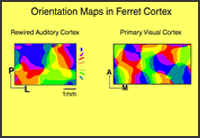

Plasticity, or the adaptive response of the brain to changes in inputs, is essential to brain development and function. The developing brain requires a genetic blueprint but is also acutely sensitive to the environment. The adult brain constantly adapts to changes in stimuli, and this plasticity is manifest not only as learning and memory but also as dynamic changes in information transmission and processing. The goal of my laboratory is to understand long-term plasticity and short-term dynamics in networks of the developing and adult cortex.
An important way by which we study plasticity and its mechanisms during development is by rewiring the brain. We induce projections from the eye to innervate nonvisual centers of the brain, such as the auditory thalamus, early in life. Since visually evoked electrical activity has a different spatial and temporal structure than auditory activity, visual inputs cause the auditory pathway to develop with a very different pattern of activity than normal. We have demonstrated that this profoundly alters neuronal networks and connectivity in the rewired auditory cortex. Furthermore, visual stimuli that activate the auditory cortex are perceived as visual (rather than as auditory), indicating that the perceptual role of a cortical area can also be shaped by its inputs early in life. We are now examining other functional consequences of the rewiring, such as serial processing in primary and higher rewired cortex, and the molecular substrates by which cortical networks respond to changes in input activity.
One of the molecules that mediates activity-dependent synaptic changes is the NMDA receptor. In a second set of studies, we examine the rules by which patterns of activity lead to functional changes in synapses and structural changes in neurons in the developing visual pathway. We examine synaptic changes during the formation and sorting of connections in the visual thalamus, and changes induced by activity in synapses and spines of cortical cells. We have recently started to examine genes that are expressed uniquely in individual cortical areas, and the ways by which patterned activity shapes gene expression.
Some of the mechanisms by which activity causes changes in the developing brain are similar to those underlying plasticity in the adult brain. In a third set of studies, we examine plasticity in the adult visual cortex using paradigms that have clear consequences for vision. For example, exposure to tilted contours of a particular orientation causes a short-term shift in the perception of vertical contours, which are seen as tilted away from the adapting orientation. We have shown that the basis for this tilt effect is short-term plasticity in the orientation tuning of neurons in the visual cortex. This plasticity is manifested particularly at certain domains in the cortex, where neurons of different orientations lie in close proximity. Thus, cortical architecture, plasticity and information processing are closely related aspects of cortical function.
My laboratory uses state-of-the-art
techniques. These include multiple electrode single unit recording in cortex,
high resolution optical imaging of activity from an expanse of cortex, whole-cell
intracellular recording in slices and in the intact brain, single cell recording
and cortical imaging in alert behaving primates, iontophoresis of transmitter
blockers combined with recording, imaging of single neurons in vitro and in
vivo using confocal and two-photon microscopy, and microarrays to identify
genes in specific tissues.



Sherman Fairchild Professor of Neuroscience
Head, Department of Brain and Cognitive Sciences
Mriganka Sur received
his Ph.D. in Electrical Engineering from Vanderbilt University. After completing
his postdoctoral training at Vanderbilt University and S.U.N.Y. Stony Brook,
he joined the faculty of the Yale University School of Medicine. In 1986,
he joined the faculty of the Department of Brain and Cognitive Sciences, becoming
Head of the Department in 1997. Dr. Sur became a member of PCLM in 2000. He
is the recipient of numerous awards, including the Charles Judson Herrick
Award, an Alfred P. Sloan Foundation Fellowship, the McKnight Neuroscience
Development Award, and the MIT School of Science Prize for Excellence in Graduate
Teaching
laboratory webpage
 |